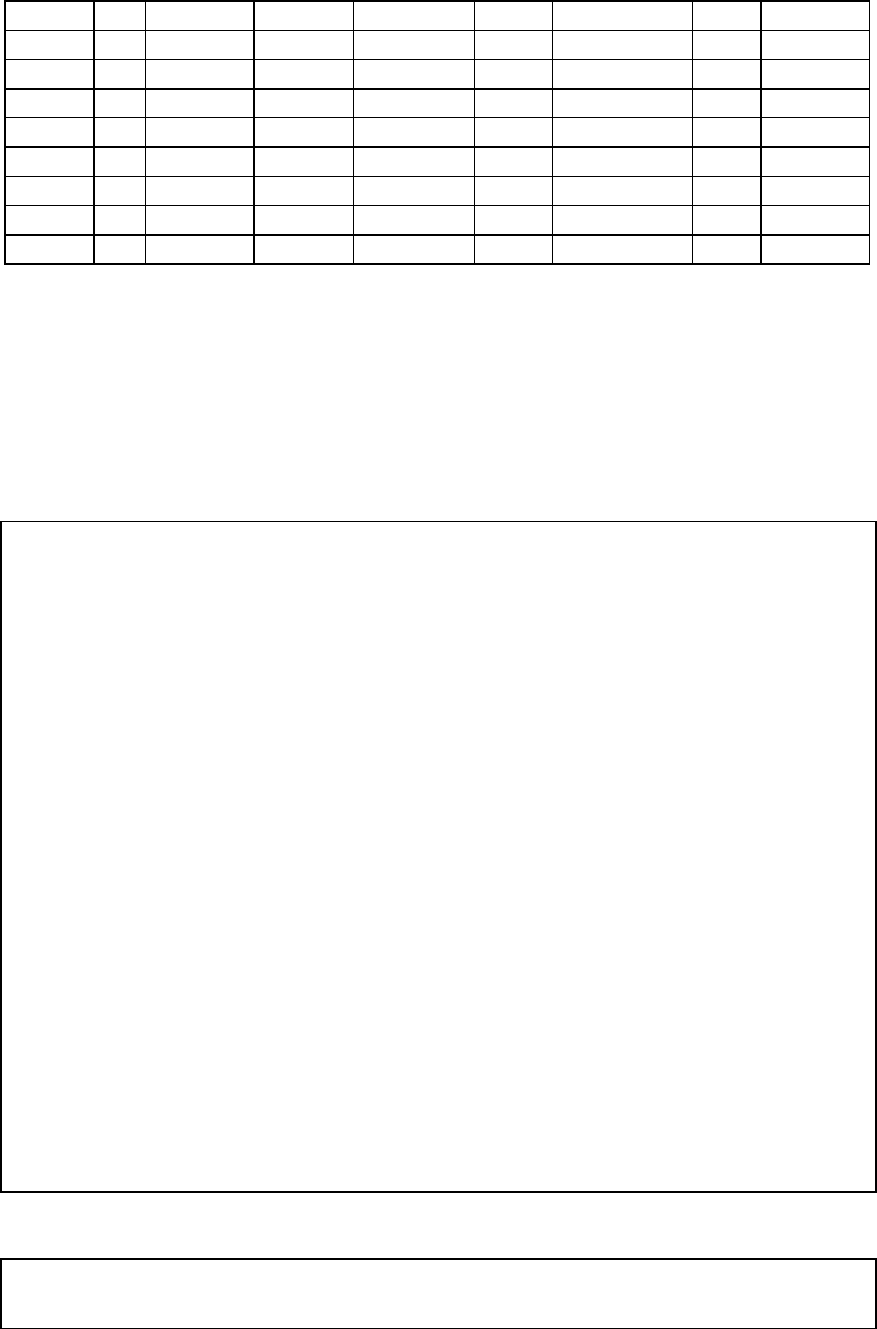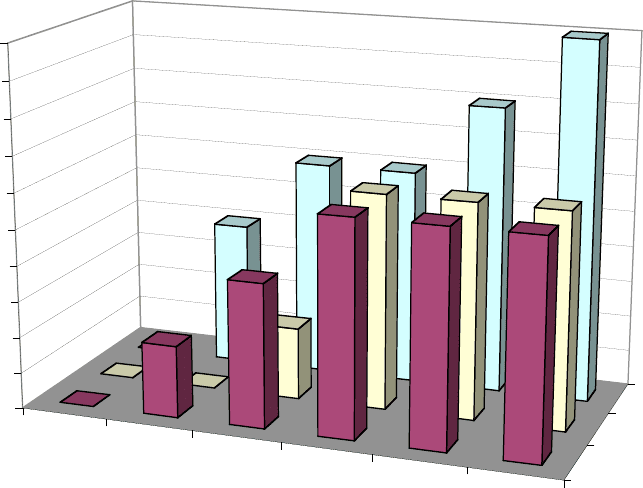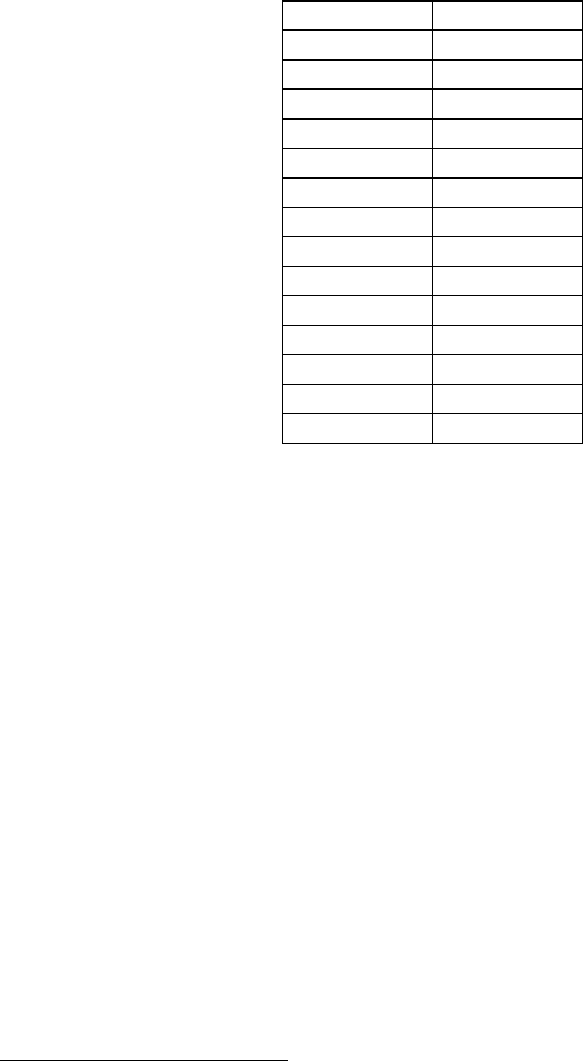Damodaran A. Applied corporate finance
Подождите немного. Документ загружается.


42
42
10%
0.47
6.29%
AAA
4.75%
38.00%
2.95%
5.96%
$115,498
20%
0.50
6.48%
AAA
4.75%
38.00%
2.95%
5.77%
$120,336
30%
0.55
6.71%
AAA
4.75%
38.00%
2.95%
5.58%
$125,597
40%
0.62
7.02%
AAA
4.75%
38.00%
2.95%
5.39%
$131,339
50%
0.71
7.45%
A+
5.30%
38.00%
3.29%
5.37%
$118,770
60%
0.84
8.10%
A
5.45%
38.00%
3.38%
5.27%
$114,958
70%
1.07
9.19%
A
5.45%
38.00%
3.38%
5.12%
$119,293
80%
1.61
11.83%
BB+
8.30%
32.43%
5.61%
6.85%
$77,750
90%
3.29
19.91%
BB
8.80%
27.19%
6.41%
7.76%
$66,966
The optimal debt ratio is the point at which the firm value is maximized. Note that the
cost of capital is actually minimized at 70% debt but the firm value is highest at a 40%
debt ratio. This is so because the operating income changes as the debt ratio changes.
While the cost of capital continues to decline as the debt ratio increases beyond 40%, the
decline in operating income more that offsets this drop.
In Practice: Building in Regulatory, Self Imposed and Lender Constraints
In most analyses of optimal capital structure, an analyst will be faced with a series of
constraints, some of which come from regulatory requirements, some of which are self
imposed and some of which are imposed by existing lenders to the firm. One very
common constraint imposed by all three is a constraint that the book value debt ratio not
exceed a specified number. Since the analysis we have done so far has focused on market
value debt ratios, there is the risk that the book value constraint may be violated. There
are two solutions:
1. The first is to do the entire analysis using book value of debt and equity, looking for
the optimal debt ratio. Since the approach we have described is driven by cash flows,
the optimal dollar debt that is computed should not be affected significantly by doing
this.
2. The second and more general approach (since it can be used to analyze any kind of
constraint) is to keep track of the book value debt ratio in the traditional analysis, and
view the optimal capital structure as the one the minimizes the cost of capital subject
to the book value debt ratio being lesser than the specified constraint.
8.6. ☞: Bankruptcy Costs and Debt Ratios

43
43
The optimal debt ratio obtained by minimizing the cost of capital is too high
because it does not consider bankruptcy costs.
a. True
b. False
Explain.
Determinants of Optimal Debt Ratio
The preceding analysis highlights some of the determinants of the optimal debt
ratio. We can then divide these determinants into firm-specific and macroeconomic
factors.
Firm-Specific Factors
Determinants specific to the firm include the firm’s tax rate, pre-tax returns and
variance in operating income.
(a) Firm's tax rate:
In general, the tax benefits from debt increase as the tax rate goes up. In relative
terms, firms with higher tax rates have higher optimal debt ratios than do firms with
lower tax rates, other things being equal. It also follows that a firm's optimal debt ratio
will increase as its tax rate increases. We can illustrate this by computing the optimal debt
ratio for Disney, Aracruz and Bookscape, holding all else constant and just changing the
tax rate in Figure 8.4

44
44
0%
10%
20%
30%
40%
50%
Disney
Aracruz
Bookscape
0%
5%
10%
15%
20%
25%
30%
35%
40%
45%
50%
Optimal Debt Ratio
Tax Rate
Figure 8.4: Optimal Debt Ratio and Tax Rate
At a 0% tax rate, the optimal debt ratio is zero for all three firms. Without the benefits
that accrue from taxes, the rationale for using debt disappears. As the tax rate increases,
the optimal debt ratios increase for all three firms but at different rates. For Aracruz and
Disney, the optimal debt ratio does not increase above 30% even if the tax rate increases
because the operating income at both firms is not high enough to sustain much higher
debt ratios; in other words, there is not enough earnings to claim additional tax benefits.
For Bookscape, though, the optimal continues to increase and reaches 50% when the tax
rate is 50%.
(b) Pre-Tax Returns on the Firm (in Cash Flow Terms):
The most significant determinant of the optimal debt ratio is a firm’s earnings
capacity. In fact, the operating income as a percentage of the market value of the firm
(debt plus equity) is usually good indicator of the optimal debt ratio. When this number is
high (low), the optimal debt ratio will also be high (low). A firm with higher pre-tax
earnings can sustain much more debt as a proportion of the market value of the firm,
since debt payments can be met much more easily from prevailing earnings. Disney, for
example, has operating income of $2,805 million, which is 4.02 % of the market value of
45
45
the firm of $69,769 million in the base case, and an optimal debt ratio of 30%. Doubling
this to 8.04% will increase the optimal debt ratio to 50%.
(c) Variance in Operating Income
The variance in operating income enters the base case analysis in two ways. First,
it plays a role in determining the current beta: firms with high (low) variance in operating
income have high (low) betas. Second, the volatility in operating income can be one of
the factors determining bond ratings at different levels of debt: ratings drop off much
more dramatically for higher variance firms as debt levels are increased. It follows that
firms with higher (lower) variance in operating income will have lower (higher) optimal
debt ratios. The variance in operating income also plays a role in the constrained analysis,
since higher variance firms are much more likely to register significant drops in operating
income. Consequently, the decision to increase debt should be made much more
cautiously for these firms.
Macro-economic Factors
Should macroeconomic conditions affect optimal debt ratios? Obviously. In good
economic times, firms will generate higher earnings and be able to service more debt. In
recessions, earnings will decline and with it the capacity to service debt. That is why
prudent firms borrow based upon normalized earnings rather than current earnings.
Holding operating income constant, macroeconomic variables can still affect optimal
debt ratios. In fact, both the level of riskfree rate and the magnitude of default spreads can
affect optimal debt ratios.
(a) Level of Rates
As interest rates decline, the conventional wisdom is that debt should become cheaper
and more attractive for firms. While this may seem intuitive, the effect is muted by the
fact that lower interest rates also reduce the cost of equity. In fact, changing the riskfree
rate has a surprisingly small effect on the optimal debt ratio, as long as interest rates

46
46
move within a normal range.
22
When interest rates exceed normal levels, optimal debt
ratios do decline partly because we keep operating income fixed. The higher interest
payments at every debt ratio reduce bond ratings and affect the capacity of firms to
borrow more.
(b) Default Spreads
The default spreads for different ratings classes tend to increase during recessions
and decrease during recoveries. Keeping other things constant, as the spreads increase
(decrease) optimal debt ratios decrease (increase), for the simple reason that higher
spreads penalize firms which borrow more money and have lower ratings. In fact, the
default spreads on corporate bonds between 1992 and 2000, leading to higher optimal
debt ratios for all firms. In 2001 and 2002, as the economy slowed, default spreads
widened again, leading to lower optimal debt ratios.
There is a dataset on the web that summarizes operating margins and returns on
capital by industry group in the United States for the most recent quarter.
Adjusted Present Value Approach
In the adjusted present value (APV) approach, we begin with the value of the firm
without debt. As we add debt to the firm, we consider the net effect on value by
considering both the benefits and the costs of borrowing. The value of the levered firm
can then be estimated at different levels of the debt, and the debt level that maximizes
firm value is the optimal debt ratio.
Steps in the Adjusted Present Value approach
In the Adjusted Present Value approach, we assume that the primary benefit of
borrowing is a tax benefit, and that the most significant cost of borrowing is the added
22
The normal range for long term interest rates in the United States for the last 40 years has been between
4 and 8%. There was a short period between 1978 and 1982 when long term interest rates were much
higher.
47
47
risk of bankruptcy. To estimate the value of the firm, with this assumption, we proceed
in three steps. We begin by estimating the value of the firm with no leverage. We then
consider the present value of the interest tax savings generated by borrowing a given
amount of money. Finally, we evaluate the effect of borrowing the amount on the
probability that the firm will go bankrupt, and the expected cost of bankruptcy.
Step 1: Estimate the value of the firm with no debt: The first step in this approach is the
estimation of the value of the unlevered firm. This can be accomplished by valuing the
firm as if it had no debt, i.e., by discounting the expected after-tax operating cash flows at
the unlevered cost of equity. In the special case where cash flows grow at a constant rate
in perpetuity,
Value of Unlevered Firm = FCFF
o
(1+g)/(ρ
u
- g)
where FCFF
0
is the current after-tax operating cash flow to the firm, ρ
u
is the unlevered
cost of equity, and g is the expected growth rate. The inputs needed for this valuation are
the expected cashflows, growth rates and the unlevered cost of equity. To estimate the
latter, we can draw on our earlier analysis and compute the unlevered beta of the firm –
β
unlevered
= β
current
/[1+(1-t)D/E]
where
β
unlevered
= Unlevered beta of the firm,
β
current
= Current equity beta of the firm,
t = Tax rate for the firm and
D/E = Current debt/equity ratio.
This unlevered beta can then be used to arrive at the unlevered cost of equity.
Alternatively, we can take the current market value of the firm as a given and back out
the value of the unlevered firm by subtracting out the tax benefits and adding back the
expected bankruptcy cost from the existing debt.
Current Firm Value = Value of Unlevered firm + PV of tax benefits – Expected
Bankruptcy cost
Value of Unlevered firm = Current Firm Value – PV of tax benefits + Expected
Bankruptcy costs

48
48
Step 2: Estimate the present value of tax benefits from debt: The second step in this
approach is the calculation of the expected tax benefit from a given level of debt. This tax
benefit is a function of the tax rate of the firm and is discounted at the cost of debt to
reflect the riskiness of this cash flow. If the tax savings are viewed as a perpetuity,
Value of Tax Benefits =[ Tax Rate * Cost of Debt * Debt] / Cost of Debt
= Tax Rate * Debt
= t
c
D
The tax rate used here is the firm’s marginal tax rate, and it is assumed to stay constant
over time. If we anticipate the tax rate changing over time, we can still compute the
present value of tax benefits over time, but we cannot use the perpetual growth equation
cited above.
Step 3: Estimate the expected bankruptcy costs
as a result of the debt: The third step is to
evaluate the effect of the given level of debt on
the default risk of the firm and on expected
bankruptcy costs. In theory, at least, this requires
the estimation of the probability of default with
the additional debt and the direct and indirect cost of bankruptcy. If π
a
is the probability
of default after the additional debt and BC is the present value of the bankruptcy cost, the
present value of expected bankruptcy cost can be estimated–
PV of Expected Bankruptcy cost = Probability of Bankruptcy * PV of Bankruptcy Cost
= π
a
BC
This step of the adjusted present value approach poses the most significant estimation
problem, since neither the probability of bankruptcy nor the bankruptcy cost can be
estimated directly. There are two basic ways in which the probability of bankruptcy can
be estimated indirectly. One is to estimate a bond rating, as we did in the cost of capital
approach, at each level of debt and use the empirical estimates of default probabilities for
Bankruptcy Cost: This is the cost
associated with going bankruptcy. It
includes both direct costs (from going
bankrupt) and indirect costs (arising from
the perception that a firm may go
bankrupt).

49
49
each rating. For instance, table 8.18, extracted from a study by Altman and Kishore,
summarizes the probability of default over ten years by bond rating class in 1998.
23
Table 8.18: Default Rates by Bond Rating Classes
Bond Rating
Default Rate
D
100.00%
C
80.00%
CC
65.00%
CCC
46.61%
B-
32.50%
B
26.36%
B+
19.28%
BB
12.20%
BBB
2.30%
A-
1.41%
A
0.53%
A+
0.40%
AA
0.28%
AAA
0.01%
Source: Altman and Kishore (1998)
The other is to use a statistical approach, such as a probit to estimate the probability of
default, based upon the firm’s observable characteristics, at each level of debt.
The bankruptcy cost can be estimated, albeit with considerable error, from studies
that have looked at the magnitude of this cost in actual bankruptcies. Studies that have
looked at the direct cost of bankruptcy conclude that they are small
24
, relative to firm
value. The indirect costs of bankruptcy can be substantial, but the costs vary widely
across firms. Shapiro and Titman speculate that the indirect costs could be as large as 25
to 30% of firm value but provide no direct evidence of the costs.
The net effect of adding debt can be calculated by aggregating the costs and the
benefits at each level of debt.
Value of Levered Firm = FCFF
o
(1+g)/(ρ
u
- g) + t
c
D - π
a
BC
We compute the value of the levered firm at different levels of debt. The debt level that
maximizes the value of the levered firm is the optimal debt ratio.
23
This study estimated default rates over ten years only for some of the ratings classes. We extrapolated
the rest of the ratings.

50
50
In Practice: Using a Probit to Estimate the Probability of Bankruptcy
It is possible to estimate the probability of default using statistical techniques,
when there is sufficient data avaialble. For instance, if we have a database that lists all
firms that went bankrupt during a period of time, as well as firms that did not go bankrupt
during the same period, together with descriptive characteristics on these firms, a probit
analysis can be used to estimate the likelihood of bankruptcy as a function of these
characteristics. The steps involved in a probit analysis are as follows:
1. Identify the event of interest: Probits work best when the event either occurs or it
does not. For bankruptcy, the event might be the filing for bankruptcy protection
under the law.
2. Over a specified time period, collect information on all the firms that were exposed to
the event. In the bankruptcy case, this would imply collecting information on which
firms that filed for bankruptcy over a certain period (say, 5 years).
3. Based upon your knowledge of the event, and other research on it, specify measurable
and observable variables that are likely to be good predictors of that event. In the case
of bankruptcy, these might include excessive debt ratios, declining income, poor
project returns and small market capitalization.
4. Collect information on these variables for the firms that filed for bankruptcy, at the
time of the filing. Collect the same information for all other firms that were in
existence at the same time, and which have data available on them on these variables.
(If this is too data intensive, a random sampling of the firms that were not exposed to
the event can be used.) In the bankruptcy analysis, this would imply collecting
information on debt ratios, income trends, project returns and market capitalization on
the firms that filed for bankruptcy at the time of the filing, and all other firms across
the period.
5. In a probit, the dependent variable is the occurrence of the specified event (1 if it
occurs, 0 if it does not) and the independent variables are the variables specified in
step 3. The output from the probit looks very much like the output from a multiple
regression, with statistical significance attached to each of the independent variables.
24
In Warner’s study of railroad bankruptcies, the direct cost of bankruptcy seems to be about 5%.

51
51
Once the probit has been done, the probability of a firm defaulting can be estimated by
plugging in that firm’s values for the independent variables into the probit. The predicted
value that emerges from the probit is the probability of default.
Illustration 8.8: Using the Adjusted Present Value Approach to calculate Optimal Debt
Ratio for Disney in 2004
This approach can be applied to estimating the optimal capital structure for
Disney. The first step is to estimate the value of the unlevered firm. To do so, we start
with the firm value of Disney in 2004 and net out the effect of the tax savings and
bankruptcy costs arising from the existing debt.
Current Market Value of Disney = Value of Equity + Value of Debt = $55,101+$14,668
= $ 69,789
We first compute the present value of the tax savings from the existing debt, assuming
that the interest payment on the debt constitutes a perpetuity, using a marginal tax rate for
Disney of 37.30%.
PV of Tax Savings from Existing Debt = Existing Debt * Tax Rate
= $14,668* 0.373 = $ 5,479 million
Based upon Disney’s current rating of BBB+, we estimate a probability of bankruptcy of
1.41% from Table 8.18. The bankruptcy cost is assumed to be 25% of the firm value,
prior to the tax savings.
25
Allowing for a range of 10-40% for bankruptcy costs, we have
put Disney’s exposure to expected bankruptcy costs in the middle of the range. There are
some businesses that Disney is in where the perception of distress can be damaging –
theme parks, for instance – but the movie and broadcasting businesses are less likely to
be affected since projects tend be shorter term and on a smaller scale.
PV of Expected Bankruptcy Cost = Probability of Default * Bankruptcy cost
= 1.41% * (0.25* 69,789) = $ 984 million
We then compute the value of Disney as an unlevered firm.
Value of Disney as an Unlevered Firm
= Current Market Value – PV of Tax Savings + Expected Bankruptcy Costs
